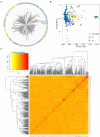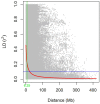Genetic Diversity and Selection Signatures in Synthetic-Derived Wheats and Modern Spring Wheat
- PMID: 35903232
- PMCID: PMC9315363
- DOI: 10.3389/fpls.2022.877496
Genetic Diversity and Selection Signatures in Synthetic-Derived Wheats and Modern Spring Wheat
Abstract
Synthetic hexaploid wheats and their derived advanced lines were subject to empirical selection in developing genetically superior cultivars. To investigate genetic diversity, patterns of nucleotide diversity, population structure, and selection signatures during wheat breeding, we tested 422 wheat accessions, including 145 synthetic-derived wheats, 128 spring wheat cultivars, and 149 advanced breeding lines from Pakistan. A total of 18,589 high-quality GBS-SNPs were identified that were distributed across the A (40%), B (49%), and D (11%) genomes. Values of population diversity parameters were estimated across chromosomes and genomes. Genome-wide average values of genetic diversity and polymorphic information content were estimated to be 0.30 and 0.25, respectively. Neighbor-joining (NJ) tree, principal component analysis (PCA), and kinship analyses revealed that synthetic-derived wheats and advanced breeding lines were genetically diverse. The 422 accessions were not separated into distinct groups by NJ analysis and confirmed using the PCA. This conclusion was validated with both relative kinship and Rogers' genetic distance analyses. EigenGWAS analysis revealed that 32 unique genome regions had undergone selection. We found that 50% of the selected regions were located in the B-genome, 29% in the D-genome, and 21% in the A-genome. Previously known functional genes or QTL were found within the selection regions associated with phenology-related traits such as vernalization, adaptability, disease resistance, and yield-related traits. The selection signatures identified in the present investigation will be useful for understanding the targets of modern wheat breeding in Pakistan.
Keywords: EigenGWAS; bread wheat; gene annotation; genetic diversity; genotyping-by-sequencing; selection signatures.
Copyright © 2022 Ali, Danting, Wang, Sadiq, Rasheed, He and Li.
Conflict of interest statement
The authors declare that the research was conducted in the absence of any commercial or financial relationships that could be construed as a potential conflict of interest.
Figures






Similar articles
-
Genome-wide variation patterns between landraces and cultivars uncover divergent selection during modern wheat breeding.Theor Appl Genet. 2019 Sep;132(9):2509-2523. doi: 10.1007/s00122-019-03367-4. Epub 2019 May 28. Theor Appl Genet. 2019. PMID: 31139853
-
Genome-Wide Analyses Reveal Footprints of Divergent Selection and Drought Adaptive Traits in Synthetic-Derived Wheats.G3 (Bethesda). 2019 Jun 5;9(6):1957-1973. doi: 10.1534/g3.119.400010. G3 (Bethesda). 2019. PMID: 31018942 Free PMC article.
-
Unlocking the novel genetic diversity and population structure of synthetic Hexaploid wheat.BMC Genomics. 2018 Aug 6;19(1):591. doi: 10.1186/s12864-018-4969-2. BMC Genomics. 2018. PMID: 30081829 Free PMC article.
-
Molecular genetic analysis of spring wheat core collection using genetic diversity, population structure, and linkage disequilibrium.BMC Genomics. 2020 Jun 26;21(1):434. doi: 10.1186/s12864-020-06835-0. BMC Genomics. 2020. PMID: 32586286 Free PMC article.
-
Genetic diversity and population structure analysis of synthetic and bread wheat accessions in Western Siberia.J Appl Genet. 2019 Nov;60(3-4):283-289. doi: 10.1007/s13353-019-00514-x. Epub 2019 Aug 14. J Appl Genet. 2019. PMID: 31414379
Cited by
-
Genetic Diversity and Genome-Wide Association Study for the Phenology Response of Winter Wheats of North America, Western Asia, and Europe.Plants (Basel). 2023 Dec 1;12(23):4053. doi: 10.3390/plants12234053. Plants (Basel). 2023. PMID: 38068688 Free PMC article.
-
Exploring the genetic diversity and population structure of an ancient hexaploid wheat species Triticum sphaerococcum using SNP markers.BMC Plant Biol. 2024 Dec 19;24(1):1188. doi: 10.1186/s12870-024-05968-8. BMC Plant Biol. 2024. PMID: 39695987 Free PMC article.
-
Association Analysis of Tiller-Related Traits with EST-SSR Markers in Psathyrostachys juncea.Genes (Basel). 2023 Oct 21;14(10):1970. doi: 10.3390/genes14101970. Genes (Basel). 2023. PMID: 37895319 Free PMC article.
References
-
- Afzal F., Reddy B., Gul A., Khalid M., Subhani A., Shazadi K. (2017). Physiological, biochemical and agronomic traits associated with drought tolerance in a synthetic-derived wheat diversity panel. Crop Pasture Sci. 68, 213–224. 10.1071/CP16367 - DOI
LinkOut - more resources
Full Text Sources

